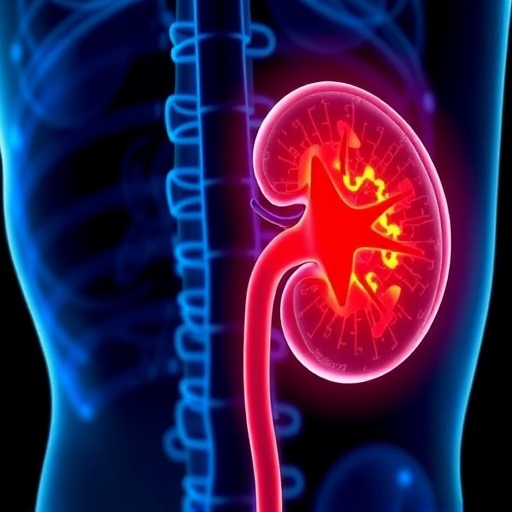Renal cell carcinoma (RCC) presents a formidable challenge in oncology due to its insidious onset and often incidental discovery. Predominantly accounting for 90% of all renal neoplasms, RCC’s early detection remains critical for improving patient outcomes yet is hampered by limitations in current diagnostic modalities. Imaging techniques, while indispensable, struggle to reliably distinguish between benign and malignant renal masses. The promise of urinary biomarkers as a non-invasive, cost-effective diagnostic adjunct has tantalized researchers for years, but a definitive solution remains elusive. A landmark systematic review published in BMC Cancer in 2025 seeks to change that landscape by meticulously condensing the vast array of urinary biomarkers under investigation for RCC diagnosis into a comprehensive, critical analysis.
This review, authored by Kelly, Samarska, Ramaekers, and colleagues, offers an unprecedented consolidation of data from 46 articles that collectively evaluated 105 unique urinary biomarkers. Spanning metabolites, proteins, microRNAs (miRNAs), DNA methylation markers, and other molecular entities, the study scrutinizes their diagnostic capabilities against control groups, emphasizing rigorous criteria such as area under the curve (AUC) values to gauge clinical utility. Notably, the systematic approach leveraged databases including PubMed, Scopus, and Web of Science, supplementing with cross-referenced literature to compile a robust and current repository of evidence.
At the heart of this inquiry lies the tension between the abundant preliminary findings and the stark reality of clinical translation failure. Biomarkers such as urinary proteins AQP1 (aquaporin-1) and PLIN2 (perilipin 2) emerged as particularly promising. These proteins are implicated in tumor-driven metabolic rerouting, offering a window into the dysregulated biochemical landscapes distinctive of RCC. Their diagnostic power, quantified by AUC scores exceeding 0.80 in several studies, underscores their potential to revolutionize non-invasive RCC detection protocols.
Equally compelling are dysregulated energy metabolism markers identified among urinary metabolites. RCC tumorigenesis involves metabolic reprogramming, redirecting normal renal cellular processes toward enhanced glycolysis and altered lipid metabolism. These biochemical signatures, detectable in urine, provide a functional snapshot that complements anatomical imaging. Metabolomic profiling, therefore, may not only differentiate malignant from benign lesions but also illuminate tumor aggressiveness and subtype-specific characteristics.
MicroRNAs—small, non-coding RNAs that regulate gene expression—further enrich the diagnostic tapestry. Among these, miR-122-5p, miR-15a, and miR-30c showed notable differential expression patterns consistently across patient cohorts. These miRNAs modulate pathways integral to tumor proliferation and apoptosis, rendering them attractive biomarker candidates. Still, the evidence compels cautious optimism, as validation studies are sparse and often limited by sample size and heterogeneity.
Intriguingly, the study illuminates that composite multi-biomarker panels frequently outshine individual markers. This synergy principle harnesses the multifactorial nature of RCC pathophysiology, where a constellation of altered molecular signals can amplify diagnostic precision. Some panels integrated metabolites with proteins or miRNAs, reflecting a layered approach to capture the complexity of tumor biology through urinary assays. This strategy might bridge sensitivity and specificity gaps encountered when relying on single biomarkers alone.
Yet, a conspicuous gap persists in external validation—an indispensable step before clinical deployment. Many promising markers and panels were identified in isolated, small-scale cohorts, frequently lacking multi-center replication or independent review. The authors particularly highlight the necessity for standardized protocols and large prospective trials to authenticate the biomarkers’ diagnostic robustness and reproducibility across diverse populations.
The systematic review does not shy away from confronting methodological hurdles inherent in biomarker research. The included studies exhibited variability in sample collection, analytical techniques, and statistical handling, factors that complicate direct comparisons and meta-analyses. For instance, urine sample handling and storage conditions critically influence biomarker stability, and disparate assays range from mass spectrometry to PCR-based methods, each introducing unique biases and limitations.
A further challenge lies in the biological heterogeneity of RCC itself, which encompasses several histological subtypes with distinct molecular underpinnings. An ideal urinary biomarker or panel would therefore need to transcend this heterogeneity or incorporate subtype-specific markers to maximize clinical relevance. The current review points toward this necessity, encouraging future research to adopt nuanced stratification frameworks in study designs.
From a translational perspective, urinary biomarkers hold immense appeal due to their non-invasive nature, ease of repeated sampling, and potential for integration into routine clinical workflows. Unlike invasive biopsies or costly imaging techniques, urinary assays could serve as frontline screening tools or adjuncts for early detection, monitoring recurrence, and guiding therapeutic decisions. This potential mandates intensified efforts to surmount existing validation and standardization barriers.
Notably, the review adheres strictly to established reporting standards, utilizing the PRISMA guidelines for systematic reviews and the modified STROBE checklist to assess study bias. Such methodological rigor lends credibility to its conclusions and provides a transparent evaluation of the evidence quality, enabling clinicians and researchers to interpret findings within a robust framework.
The implications of this comprehensive review reach beyond RCC alone. They exemplify the broader biomarker development paradigm in oncology, highlighting the intricate balance between promising molecular discoveries and the pragmatic pathways toward clinical impact. The blueprint proposed underscores the indispensability of collaborative, multidisciplinary research efforts encompassing molecular biology, clinical oncology, bioinformatics, and biostatistics.
In summary, the 2025 systematic review in BMC Cancer heralds a pivotal moment for RCC diagnostics, synthesizing diverse molecular insights into a coherent narrative of potential and pitfalls. While urinary biomarkers such as AQP1, PLIN2, key metabolites, and select miRNAs exhibit commendable diagnostic promise, their clinical utility hinges on rigorous, large-scale validation and multi-marker panel refinement. This evolving field eagerly awaits future studies to cement these biomarkers’ roles, signaling a transformative advance toward non-invasive, precise RCC diagnosis.
Subject of Research: Diagnostic urinary biomarkers for renal cell carcinoma (RCC)
Article Title: Renal cell carcinoma detection: a systematic review in diagnostic urinary biomarkers
Article References: Kelly, J.F., Samarska, I.V., Ramaekers, B. et al. Renal cell carcinoma detection: a systematic review in diagnostic urinary biomarkers. BMC Cancer 25, 1672 (2025). https://doi.org/10.1186/s12885-025-14900-8
Image Credits: Scienmag.com
DOI: https://doi.org/10.1186/s12885-025-14900-8
Keywords: Renal cell carcinoma, RCC, urinary biomarkers, diagnostic biomarkers, metabolites, proteins, microRNAs, DNA methylation, multi-biomarker panels, non-invasive cancer detection




